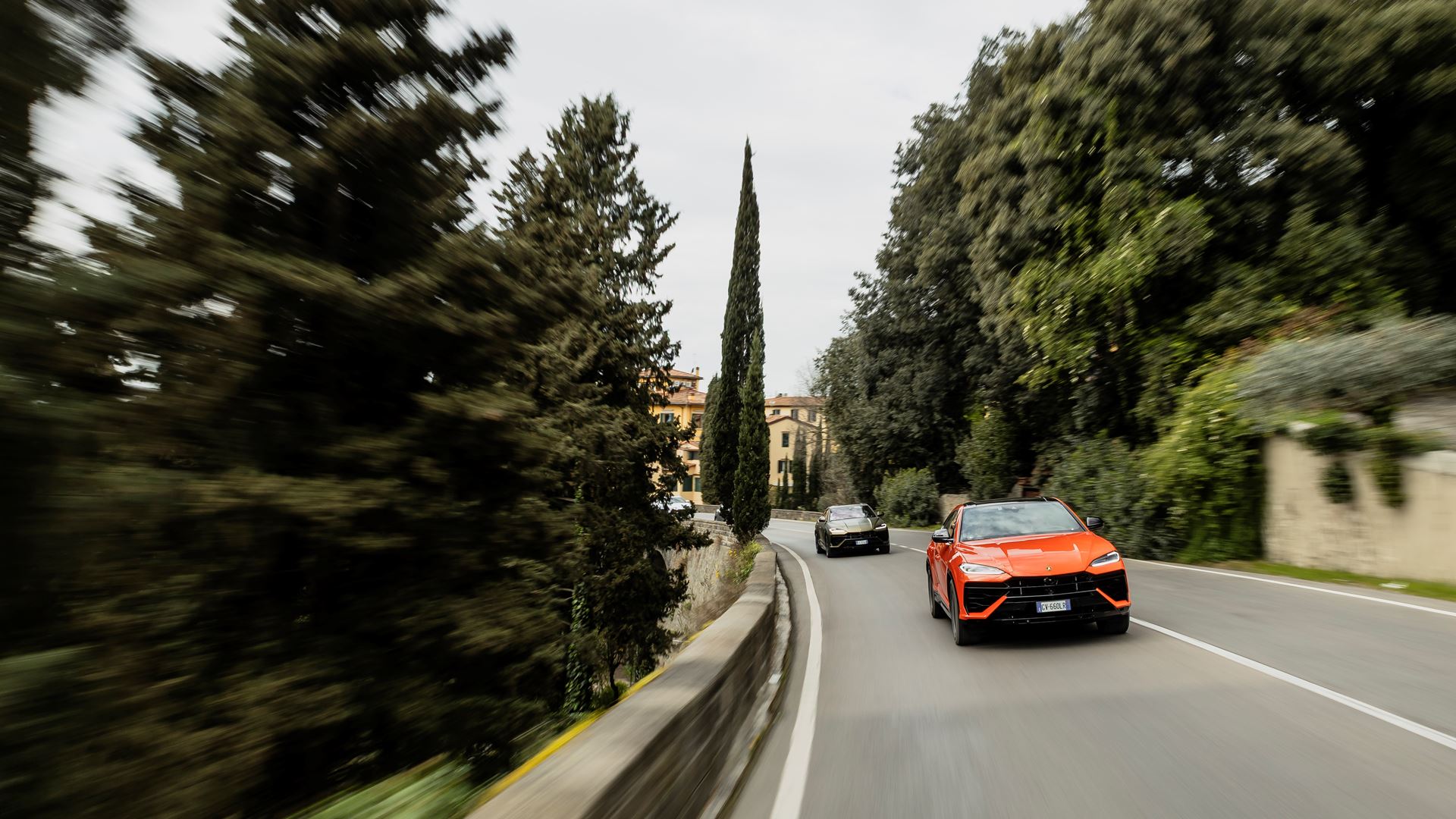Heading along the steep country road that leads to the imposing Tenuta di Artimino, once a Medici family hunting lodge, I am trying to sneak a peek at its signature 100 chimneys. It’s going fine until I’m unceremoniously jolted out of my appreciation of medieval architecture by the need to change gears.
It’s normally a straightforward shift, but today I practically have to stand up to reach the point of clutch engagement. Relieved when I manage it without a hiccup, I catch an appreciative nod from the Lamborghini engineer seated beside me—the man who, before we could set off, had to reach down my side to release the handbrake for me. This was not a car built with short middle-aged women in mind.
The LM 002 may not be the vehicle I travelled to Italy to drive, but it’s a cool bonus. Considered the OG when it comes to the exotic luxury SUV market, it went into production in 1986, with only 301 models ever made. And despite its genuinely impressive credentials (able to climb a gradient of 120 degrees and with a maximum speed of 210 kilometres per hour), its hefty tank-like bulk was designed for off-road force, not day-to-day functionality.
The same charge could not be levelled at the LM 002’s thoroughly modern descendent, the Lamborghini Urus SE. As sleek and elegant as one would expect from the Italian automobile manufacturer, it ups the Urus ante by becoming the first plug-in hybrid (PHEV) version of the range—and currently, the only model available to purchase.

We started our Urus SE journey a 30-minute drive from the centre of the historic city of Bologna, at Lamborghini headquarters in the hamlet of Sant’Agata Bolognese. Comprising the design, administrative, and production arms of the company, as well as the small but beautifully formed museum, the Lamborghini lot dominates the physical and economic landscape of this small village. What began as a 10,000-square-metre footprint in 1963 had expanded to 345,000 square metres by 2023, with the bulk of the expansion as a result of increasing demand for the Urus after its launch in 2018.
The introduction of the Urus, described by Lamborghini as the “first Super Sport Utility Vehicle,” was a game changer for the manufacturer, providing a more practical vehicle for everyday use than its powerful supercars. It has proven a massive success by any measure. Whereas only a handful of Temerarios are produced daily, the Urus line pumps out 40 finished vehicles in the same time period, and the entire 2025 output has been preordered by customers. If you want one of these slick roadsters, you need to plan ahead.
“We are not selling mobility; we are selling dreams,” the charismatic Lamborghini president, Stephan Winkelmann, insists during a presentation in the company auditorium. These are, he says, “cars to be driven, not stored as investments.” And, he makes clear, despite the commitment to sustainability—the factory, for example, has been rated carbon neutral since 2015, and the stated goal is for a fully electric vehicle range by 2030—performance will always come first.
Entering the self-contained Urus factory line feels like stepping onto the set of a futuristic movie. Magnets beneath the floor move vehicles in various stages of completion from section to section. Each stop on the line is 30 minutes, and the time is counted down on large digital screens that are easily visible to staff. There are also screens that show how many cars have been completed that day across the three shifts that cover almost 24 hours, from 6 a.m. to 3 a.m. Small parts are collected from the storage bins and delivered to individual stops by robots, and although huge robotic arms are everywhere on the line, they are there purely, we are told, to manoeuvre the car frames into positions that make it easier for workers, both in terms of access and by removing any lifting or physical strain. Lamborghini is proud of its reputation for building by hand.

Each car arrives on the line with its exterior and interior colour scheme fully set. In a further nod to sustainability, Lamborghini has brought the paint process in house (it was previously handled elsewhere). Customers have a dizzying selection of colour combinations and paint effects to choose from and can, if they prefer, visit the Ad Personam customization studio on-site at Sant’Agata Bolognese to make their selection. Less practical for Canadians, perhaps, is the ability to collect a finished car in person and drive it off the factory lot.
Related stories
- With Ghost Series II, Rolls-Royce Aims to Enhance and Refine
- Mercedes-Benz Refuels the G-Class Into an EV with Star Power
- Korea’s Luxury Car Game Is Making Waves
The next day finds us on the outskirts of Bologna at the local Lamborghini dealership, where a line of Urus SEs in an array of colours from signature Lamborghini orange through to a matte olive green awaits. We are headed to Florence via the storied Futa Pass in the Tuscan-Emilian Apennines—a twisty mountain pass beloved of adrenaline-fuelled motorcyclists and drivers alike. The temptation to put the Urus through its paces here is strong, but this isn’t my own car, and these are public roads. Still, having seen it driven around a track at speed, I know what it is capable of. And it’s no slouch at its maximum speed of 312.2 kilometres per hour and the ability to go from 0-199.5 kilometres per hour in 11.2 seconds.

Despite an increasingly forbidding storm, inside the Urus SE the atmosphere could not be more serene. The level of luxurious finish is hardly a surprise, but it doesn’t diminish the pleasure of such a high-spec interior where every possible comfort has been anticipated and controls and adjustments are a mere fingertip away. The road to the top of the pass is, as advertised, a succession of switchbacks that could cause even the least motion-affected among us some issues, but the Urus takes it in stride. I don’t realize just how hard the wind is whipping until we stop at the Passo della Futa bar and restaurant, which has been providing a pit stop to road adventurers since 1890, and I am literally blown across the road.
Back down the other side, the sun reappears as we weave our way through the picture-perfect Florentine countryside and onto the grounds of the UNESCO World Heritage Site Tenuta di Artimino. We may be centuries apart, but sitting in this exemplary vehicle while approaching an architectural marvel, one thing is clear: good design never goes out of style.
Read more from our Summer 2025 issue.









